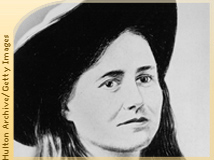
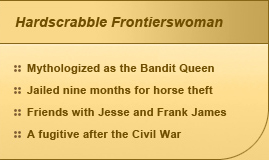
It seems that I have more trouble than any other person.
—Belle Starr
Belle Starr lived her life on the run in the late-1800s American West. She was a convicted horse and cattle rustler who associated with notorious thieves, thugs and murderers. The “Petticoat Terror of the Plains” became one of the West’s most famous female antiheroes. Newspaper reports detailed her violent exploits, including heading an outlaw gang, acting as a whorehouse madam and committing serial murder. While contemporary scholarship has disproved many of these claims, Starr’s life still challenges society’s preconceptions about frontier women.
Velvet & Six-Shooters: A Girlhood
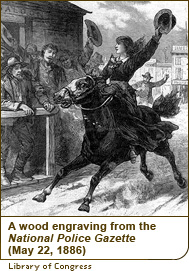 Myra Maybelle Shirley was born in 1848 on a farm near Carthage, Missouri. Young May, or Belle, was the middle child of John Shirley and Eliza Pennington and was raised with refinement. She took piano lessons and attended the Carthage Female Academy. There she learned music, manners, Greek, Latin and Hebrew. She also developed a penchant for clothing made of velvet. Her older brother, Bud, taught Belle other skills she’d find useful: how to ride horses and wield a six-shooter. She shined at both.
Myra Maybelle Shirley was born in 1848 on a farm near Carthage, Missouri. Young May, or Belle, was the middle child of John Shirley and Eliza Pennington and was raised with refinement. She took piano lessons and attended the Carthage Female Academy. There she learned music, manners, Greek, Latin and Hebrew. She also developed a penchant for clothing made of velvet. Her older brother, Bud, taught Belle other skills she’d find useful: how to ride horses and wield a six-shooter. She shined at both.
During the Civil War, Belle’s father sided with the Confederates, and the family’s US$10,000 net worth plummeted. Bud joined a rebel militia and was killed. Several accounts suggest that a teenage Belle joined the militia too.
After the war, Confederate guerrilla fighters were branded as fugitives, so the Shirley family moved farther south to a farm in Texas. There, Shirley hosted the remnants of his son’s militia, who had become full-fledged outlaws. Jim Reed, one of these men, married Belle in 1866. Two years later, their daughter Rosie Lee (nicknamed Pearl) was born. Today, there is speculation as to the identity of the child’s real father, Reed or another infamous outlaw of the time, Cole Younger.
The Female Jesse James?
Whether Starr’s life of crime was a choice, a result of her upbringing or the by-product of her association with unsavory suitors, she excelled in stealing horses and pulling her pistol on posses. In a region brimming with nefarious characters, Starr stood out in part thanks to her apparel, as she conducted her activities clad in velvet dresses and feathered hats. She had a keener eye for clothing than she did for men. Each of her three—or four—husbands was a desperado, a cheat, a doomed man or a combination of the three.
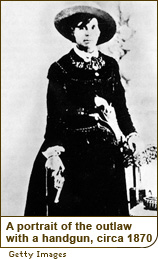
Reed’s specialty was robberies, whereas Belle’s next husband (Reed died in a gun fight in 1874), Sam Starr, excelled at smuggling whiskey and stealing horses. The couple settled into a quiet life on the Canadian River in what is now Oklahoma, fencing stolen goods and providing shelter for scoundrels such as Jesse James. Starr quickly mastered the art of running a livestock-stealing ring.
In 1882, Starr was convicted of horse theft in Fort Smith, Arkansas, and sentenced to two six-month sentences. During the trial, Starr was romanced by her longest-lasting suitor: the press. She posed for pictures before going to jail and was called “a maroon Amazon,” a racist epithet inspired by her marriage to Sam Starr, a Cherokee.
After Starr’s release, she returned to rustling. Four years later, Starr was arrested twice more for theft; at trial, she was found not guilty due to lack of evidence. After Sam died in a shoot-out, Starr married Bill July, a Creek Indian, so that she could maintain her property claim in Indian Territory.
A few months after the marriage, Starr was murdered. On February 3, 1889, a cowardly shotgun blast from behind unseated the 41-year-old woman from the horse she was riding. Suspects included Edgar Watson, a would-be tenant on Starr’s land; Starr’s husband, who had taken a mistress; and Starr’s son, Ed. No one was ever convicted.
Mythic Starr
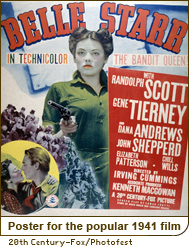
Much of Starr’s mythology derives from a pulp novel published just after her murder. Bella Starr [sic], the Bandit Queen, or the Female Jesse James was a work of fiction from publisher Richard K. Fox’s 25-cent crime series, National Police Gazette. Fox took Starr’s basic biography from an obituary in the New York Times. Then his writer, doing scant research, embellished. Thousands of copies of the sensationalized story were sold, and an enduring legend was launched.
The adventure tale presented the Bandit Queen as a hero, transforming her from a horse thief to a colorful all-around criminal similar to Robin Hood. This fictitious figure was inflated further by Hollywood, first in Belle Star (1941), a film starring Gene Tierney as Belle Starr, then again in Montana Belle (1952) with Jane Russell. American folksinger Woody Guthrie even wrote a song about Starr in the 1940s, celebrating her as a populist hero.
Starr stories flourished even in the face of contradictory evidence. In 1910, a top newspaperman from the St. Louis Republic investigated Starr’s life. He concluded that “it is doubtful if she ever did more than steal horses.” Even so, Starr’s style and expert horsemanship set her apart from your everyday outlaw.
:: woa.tv staff
Belle Starr Selected Sources





